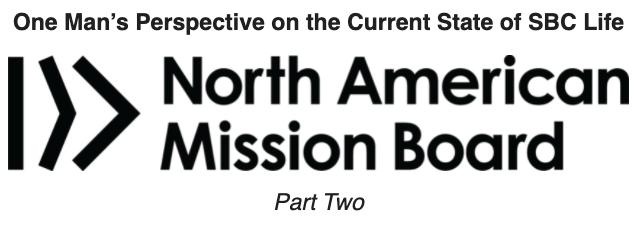|
Let me pick back up with my race through Baptist history. By 1880, “Southern Baptists began to debate seriously both in the Convention sessions and elsewhere whether a southern Home Mission Board (HMB) was really needed since the associations and state bodies in the South and the northern society were so active in the work.” These tensions created a “rivalry with the state bodies in the South, [and] not only radically diminished the receipts of the [HMB] but also closed many areas of work to it.”4 Established societies continued to do well in spite of the fact that “nearly half of all the offerings…was used for collection and administration.”5 We were still struggling to see the value of cooperation!
“The convention took radical action in 1882. Messengers voted to dismiss not only the secretary of the HMB but the entire elected board of trustees and move the headquarters to Atlanta.”6 A new Corresponding Secretary (I. T. Tichenor) was elected, a new office location was established (moving from Marion, AL), and a renewed passion to work together across the south was envisioned. “In Tichenor’s last year as secretary in 1899, 671 missionaries were supported jointly with the state boards. Alabama, Arkansas, Missouri, Mississippi, North Carolina, Oklahoma Territory, Tennessee, Texas, and Virginia were cooperating with the board in part or all of their work.”7 A significant step had taken place and once again leadership paved the way! Fast forward to the 1920s. The decade brought huge challenges. A deep agricultural recession caused the “two mission boards [to] cut their work to the bone in massive retrenchment; other SBC institutions, especially the seminaries, faced imminent foreclosure; and the SBC and its entire assets could probably have been thrown into bankruptcy proceedings had the creditors desired.” If that wasn’t bad enough the “SBC received another jolt in 1928 at the revelation that Clinton S. Carnes, treasurer of the Home Mission Board, had embezzled $909,461 from the agency.”8 But in the midst of those great challenges the Cooperative Program (CP) was adopted. “Launched in 1925 the plan called for churches to send their offerings for denominational ministries to their state conventions. The states, in turn, would retain a portion of the funds for work within the state, forwarding the rest to the SBC office in Nashville.”9 The convention had struggled for eighty years in an effort to get traction for its convention model. Societal style fund raising for the fledgling convention had been a failure. Baker notes in his book, “The significance of the adoption of the Cooperative Program resides in its correction of the ambivalence in the financial methods carried over from the society plan in 1845 and its exploiting of the genius of the convention-type program. The Cooperative Program brought the goal of the original constitution of 1845 closer to realization.”10 Collaboration became real! As we approach the 100th Anniversary of the Cooperative Program, the SBC funding model has become the envy of every other denomination in America. “Cooperative is the right word to describe this stewardship program, and it shows the near canonization of both the word and the concept among Southern Baptists. To be ‘non-cooperative’ is a serious thing to Southern Baptists, and to be ‘independent’ has become a severe criticism.”11 The dream of an organized convention of churches replacing the old societal model had come to fruition. But what happened to the idea of Southern Baptists becoming a national body of churches? In 1900, formal alignment of churches was still limited to those in the original fourteen states with two exceptions: the District of Columbia and the Oklahoma and Indian Territories. Through a series of conferences with the American Baptist Home Mission Society that began in 1894 the first new state convention to be added was New Mexico in 1912. Churches in Oklahoma which had been dually aligned with Baptists in the north since statehood in 1907, became solely SBC aligned in 1914. The depression and the dust bowl migrations resulted in SBC leaning churches being planted in California. Their desire to affiliate with SBC life led to a decision at the 1942 SBC Convention in San Antonio to recognize California. Before the Kansas Convention was formally accepted, it was discussed at three national conventions, 1946-1948. A committee was appointed at the 1947 meeting to bring a recommendation on “The Kansas Application.” They recommended that in light of agreements with northern Baptists the application should not be approved. A floor amendment passed which reversed the committee’s recommendation. This action opened the door to further national expansion over the next two decades. Migration from historical SBC areas during and following World War II to fill jobs in the more industrialized northern states, to staff the military bases many of which were outside the south, and to explore the oil and mineral-rich areas in northern and western states led to a more national vision on the part of Southern Baptists. The first Southern Baptist Church in the south was FBC Charleston, South Carolina, and it was established in 1682. By contrast, the first SBC churches in the Upper Midwest are as follows: North Dakota—First Southern Baptist Church, Ray (later disbanded), 1953 Iowa—Fairview Baptist Church, Anamosa, 1954 Nebraska—First Southern Baptist Church (Southview), Lincoln, 1955 South Dakota—First Southern Baptist Church, Rapid City (now Calvary), 1955 Minnesota—Southtown Baptist Church, Bloomington, 1956 In 1961 with the formation of a mission congregation in Vermont, Southern Baptists could finally claim a presence in all fifty states. After the initial excitement died down, the hard work began of strengthening and expanding churches in the newer work states. However, by 1980 some of those areas began to see the number of SBC churches and church membership plateau or, in a few cases, even decline. The strategy of congregationalizing former southerners who had migrated north and west had run its course. It was time for new mission strategies to be developed! 4Page 260 of Robert A. Baker’s book The Southern Baptist Convention and Its People 1607-1972 5Page 240 of Robert A. Baker’s book The Southern Baptist Convention and Its People 1607-1972 6Page 428 of H. Leon McBeth’s book The Baptist Heritage. 7Page 264 of Robert A. Baker’s book The Southern Baptist Convention and Its People 1607-1972 8Page 620 of H. Leon McBeth’s book The Baptist Heritage. 9Pages 621-622 of H. Leon McBeth’s book The Baptist Heritage. 10Page 404 of Robert A. Baker’s book The Southern Baptist Convention and Its People 1607-1972. 11Page 622 of H. Leon McBeth’s book The Baptist Heritage. Yours in Christ, Mark R. Elliott, DoM
0 Comments
Leave a Reply. |
AuthorRetired in April 2022, Mark R. Elliott served as a Director of Missions (Associational Mission Strategist) in Western Iowa and Eastern Nebraska for almost three decades. He is a strong advocate for obedience and Biblically based disciple making. As such, he knows that making healthy disciples requires Christian leaders to be constantly pursuing spiritual maturity—be lifelong learners. Because of the time constraints of ministry, most pastors focus their reading list on resources that assist them in teaching and preaching the Word of God. As such, books focusing on church health, leadership development, and church growth tend to find their way to the bottom of the stack. With that reality in mind, Mark has written discussion summaries on several books that have helped him to personally grow in Christ and that tend to find themselves on the bottom of most pastor’s stack. Many pastors have found them helpful as they are able to more quickly process great insights from other pastors and authors. Archives
April 2022
Categories |
Looking for something? |
© COPYRIGHT 2024. ALL RIGHTS RESERVED.
|




 RSS Feed
RSS Feed
